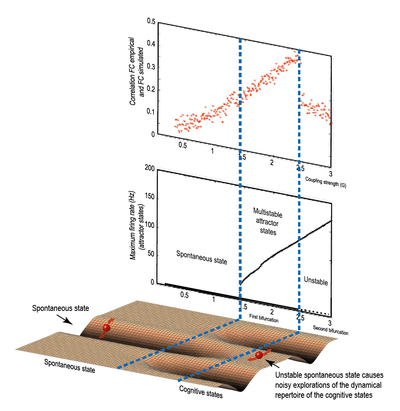Gustavo Deco
| Gustavo Deco | |
|---|---|
|
Professor Gustavo Deco | |
| Born | Rosario, Argentina |
| Residence | Spain |
| Nationality | Italy |
| Fields | Neuroscience, Cognitive Science |
| Institutions | Pompeu Fabra University |
| Notable awards | Siemens "Inventor of the Year" (2001) |
Gustavo Deco is an Argentinian and Italian professor and scientist. He serves as Research Professor at the Catalan Institution for Research and Advanced Studies and Full Professor (Catedratico) at the Pompeu Fabra University, where he is Director of the Center of Brain and Cognition and head of the Computational Neuroscience Group. In 2001 Deco was awarded the international price of Siemens "Inventor of the Year" for his contributions in statistical learning, models of visual perception, and fMRI based diagnosis of neuropsychiatric diseases.. He is married with Maria Eugenia Granitto and father of Nikolas, Sebastian, Martin and Matthias Deco.
Training
Deco holds three doctorates in interrelated disciplines. A Ph.D. in physics was bestowed by the National University of Rosario (Argentina) (1987), a habilitation in Computer Science was bestowed by the Technical University of Munich (1997), and a PhD in psychology was bestowed by the Ludwig-Maximilian-University of Munich (2001). These degrees were obtained whilst holding a number of research posts. In 1987, he held a post-doctoral fellowship at the University of Bordeaux. In 1988 and 1999, he was a postdoc fellow at the Alexander von Humboldt Foundation at the University of Giessen in Germany. From 1993-2003 he led the Computational Neuroscience Group in the Neural Computing Section of the Siemens Corporate Research Center in Munich, Germany.
Deco has held lecturing posts at Rosario, Frankfurt and Munich and, since 2001, invited lecturer post at the Ludwig-Maximilian-University of Munich. He was Associate Professor at the Technical University of Munich and Honorary Professor at the University of Rosario in 1998. From 2001-2009, he was a McDonnell-Pew Visiting Fellow at the Centre for Cognitive Neuroscience at the University of Oxford.
Academic contributions
Deco has made important contributions on a number of topics including computational neuroscience, neuropsychology, psycholinguistics, biological networks, statistical formulation of neural networks, and chaos theory.[1] His most highly cited research focuses on whole-computational modelling of ongoing spontaneous activity in resting-state networks, and thus providing a causal understanding of these important networks in health and disease.[2] Deco is currently investigating these research questions in his advanced ERC grant “The Dynamical and Structural Basis of Human Mind Complexity: Segregation and Integration of Information and Processing in the Brain”.

In his research, Deco has used large-scale cortical models where the networks teeter on the edge of instability.[4] In this state, the functional networks are in a low-firing stable state while they are continuously pulled towards multiple other configurations. Small extrinsic perturbations can shape task-related network dynamics, whereas perturbations from intrinsic noise generate excursions reflecting the range of available functional networks. This is particularly advantageous for the efficiency and speed of network mobilization. Thus, the resting state reflects the dynamical capabilities of the brain, which emphasizes the vital interplay of time and space. Ongoing research concentrates on characterizing these functional and structural networks in health and disease with a view to creating a new discipline of computational neuropsychiatry.[5]
Bibliography
- Books
- G. Deco and D. Obradovic (1996) "An Information-Theoretic Approach to Neural Computing", Springer Verlag, New York.
- G. Deco and B. Schürmann (2000) "Information Dynamics: Foundations and Applications", Springer Verlag, New York.
- E. Rolls and G. Deco (2001) "Computational Neuroscience of Vision", Oxford University Press, Oxford.
- E. Rolls and G. Deco (2010) "The Noisy Brain", Oxford University Press, Oxford.
- Articles
- ↑ Deco G, Tononi G, Boly M, Kringelbach ML, 2015, "Rethinking Segregation and Integration: Contributions of Whole-Brain Modelling", Nature Reviews Neuroscience, 16:430–439.
- ↑ Deco G, Kringelbach ML, 2016, "Metastability and Coherence: Extending the Communication through Coherence Hypothesis Using A Whole-Brain Computational Perspective", Trends in Neurosciences, 39:125–135.
- ↑ Deco G, Jirsa VK, McIntosh AR, 2013, "Resting Brains Never Rest: Computational Insights into Potential Cognitive Architectures", Trends in Neurosciences 36:268-274.
- ↑ Kringelbach ML, McIntosh AR, Ritter P, Jirsa VK, Deco G, 2015, "The Rediscovery of Slowness: Exploring the Timing of Cognition", Trends in Cognitive Sciences, 19:616–628.
- ↑ Deco G, Kringelbach ML, 2014, "Great Expectations: Using Whole-Brain Computational Connectomics for Understanding Neuropsychiatric Disorders", Neuron, 84(5):892-905.
Sources
- External links
Computational Neuroscience Group
